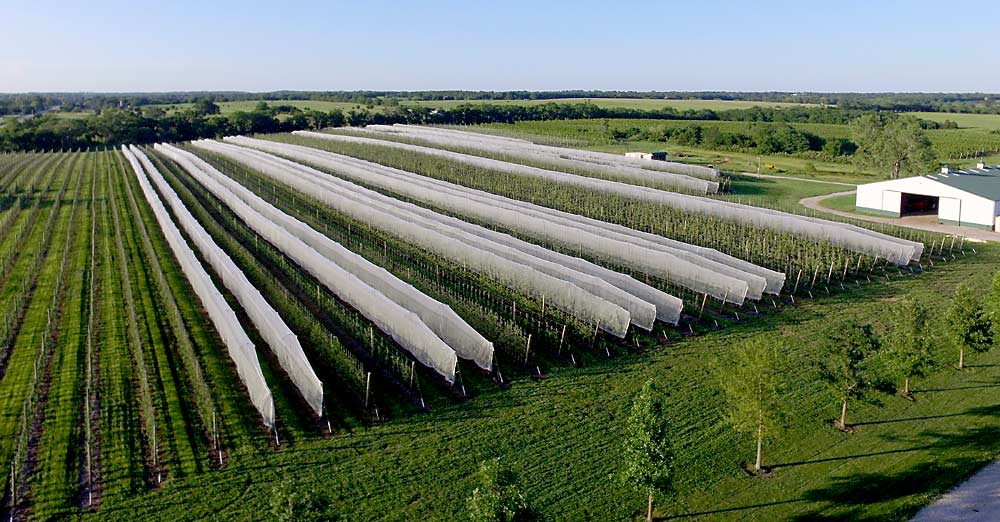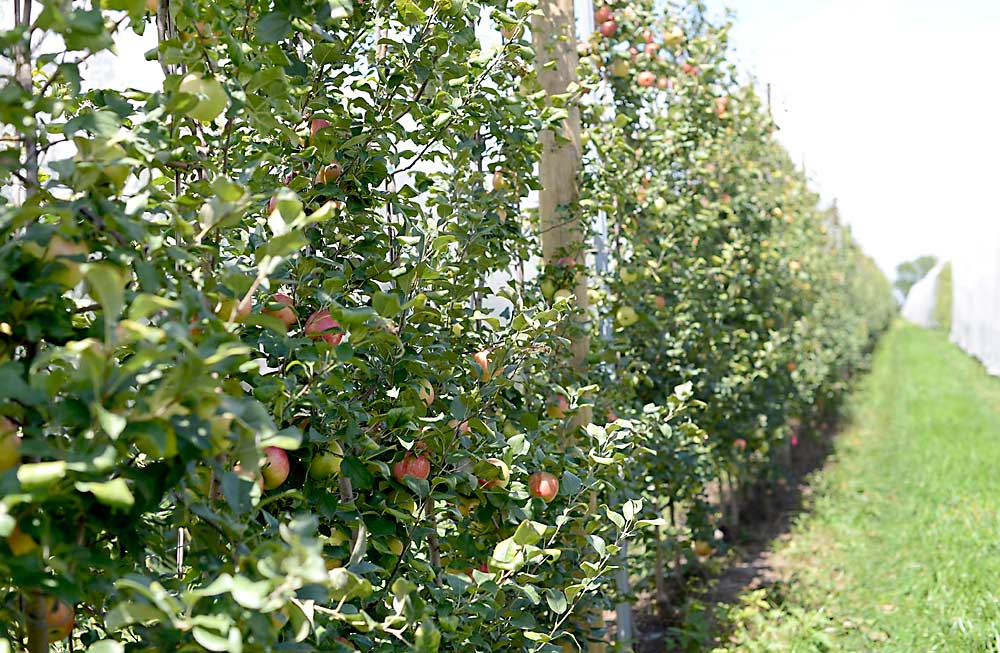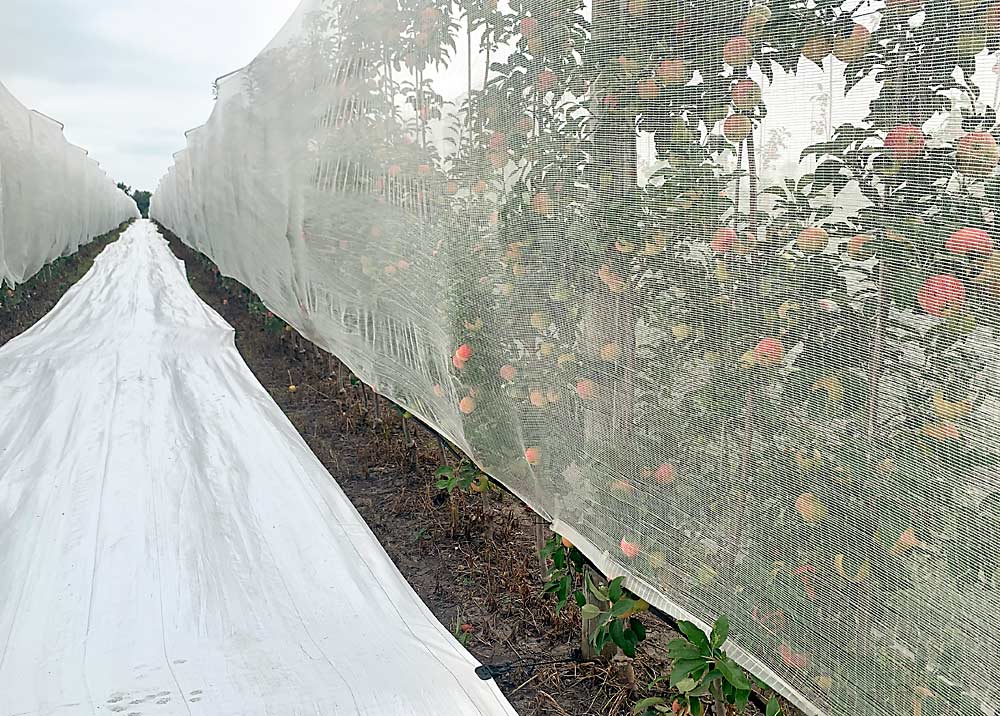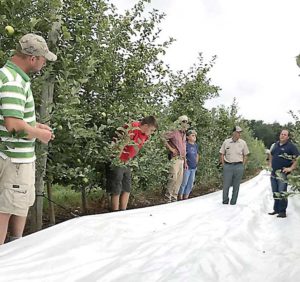
Eastern Kansas hasn’t been known for tree fruit since the Armistice Day Blizzard in November 1940 killed a huge percentage of the region’s fruit trees. In the aftermath, local farmers decided commodity crops were a better bet.
Small U-pick orchards lingered in the region for decades, remnants of the old days, but the high-density plantings that gradually took root in America’s thriving apple enclaves were not to be seen. But with a known history of apple production and proximity to population centers such as Kansas City and Wichita, perhaps it was only a matter of time before local growers took the plunge into modern apple orcharding.
Two farms in eastern Kansas, South Baldwin Farms and Gieringers Family Orchard & Berry Farm, recently planted high-density apple blocks. Both farms are on the outskirts of metropolitan Kansas City. And though they’re utilizing different sales channels, both show that high-density apples, with certain protective measures in place, are a viable option for local fruit growers.
Peter Pierson, project manager for the Kansas Specialty Crop Growers Association, said growers in eastern Kansas are planting more fruit — including apples, grapes, berries and stone fruit — to take advantage of greater revenue potential on smaller parcels of land, compared to what they’d get from traditional row crops. Reflecting that growth, the Kansas Vegetable Growers Association was reconstituted into the Kansas Specialty Crop Growers Association in 2019 to embrace a broader range of crops. Gabe Spurgeon, farm manager at South Baldwin Farms, is the association’s current president, and Brice Wiswell, co-owner of Gieringers, is vice president, Pierson said.
Spurgeon became a full-time fruit grower after his father-in-law, Dave Miles, owner of South Baldwin Farms, planted some apple and peach trees on trellises about a decade ago. Spurgeon thought it would be fun to scale up the plantings and maybe expand sales beyond the farm. They currently grow about 15 acres of apples and 13 acres of peaches, along with a smattering of nectarines, cherries, blackberries and pumpkins.

They planted high-density orchards starting in 2015, and a lot of those trees are coming into full production. They started with Budagovsky 9 rootstock, but that seems to “runt out” in the area, he said, and now Spurgeon prefers Geneva 41.
Spurgeon loves growing peaches, but they’re a risky proposition in the region: Freezes destroyed most of his last two crops. (Apples are safer in this regard, because they bloom after the greatest frost risk has passed.)
They’re in the process of planting an additional 35 acres of apples, at a 2.5- by 11.5-foot spacing, all on G.41. Their apple mix includes Honeycrisp, Gala, EverCrisp, Ludacrisp, Pink Lady, Jonathan, Crimson Crisp, Topaz, Fuji, Sweet Maia and Autumn Crisp. They also grow hard cider varieties including Arkansas Black, Dabinett, Golden Russet and Ashmead’s Kernel, which they sell to local wineries.
South Baldwin Farms sells some of its fruit via U-pick and on-farm store, but most of its apples go to regional grocery stores or other farm stands. The demand for local produce has created an opportunity. Until recently, the farm was in its “awkward middle school phase” — too much fruit to sell directly but not enough to interest distributors, Spurgeon said. But they recently formed a partnership with a company that distributes their fruit to regional grocery stores and to Fort Leavenworth, a large military base in the area, he said.
Wiswell runs Gieringers Family Orchard & Berry Farm, a diverse fruit and vegetable farm focused on on-farm sales, with his mother and stepfather. They planted their first apple trees on trellis in spring 2018, mostly on G.41 with some G.935. They now have about 7 acres of apples, with a large number of varieties because they want customers to have apples to pick all season. Varieties include Ultima Gala, Pixie Crunch, Crimson Crisp, Fuji, Autumn Crisp, Jonathan, Royal Empire, Jonagold, Crunch-A-Bunch, Rosalee, Pink Lady, Maslin, Ludacrisp, EverCrisp, SnapDragon and, of course, Honeycrisp.
“Honeycrisp is not the best apple to grow in our area, but people will pay for it,” Wiswell said.
They’ll plant another 2 acres in the next couple of years. Fall crowds are growing, and they want enough apples to satisfy everyone — but not so many that there’s a lot left at the end of the season, Wiswell said.
Though growing apples in Kansas is feasible, it’s not exactly easy. It’s hot and humid, hailstorms are frequent, and insects and fungal diseases thrive. The sun is intense when the apples are ripening, and the nights are rarely cool enough for the fruit to color properly. That’s definitely a problem for Honeycrisp, Spurgeon said.

Seeking better protection from some of those problems, Spurgeon and Wiswell decided a couple of years ago to work with Zac Hoppenstedt, the local Kansas State University horticulture extension agent, to trial protective netting and reflective fabric in their apple orchards.
With help from a state grant, they bought some Drape Net netting and Extenday groundcover, as well as a hydraulic applicator machine for the netting. The one-year trial was conducted in 2020. Hoppenstedt was still analyzing the yield, marketability, fruit quality and other data this summer, but he said one major takeaway was that reflective fabric laid between rows can increase red coloring on Honeycrisp — with or without netting.
Spurgeon invested in additional netting and groundcover. He now can lay the reflective fabric wherever he needs to improve apple color. He covers about half of his apple trees in the netting, which also provides some protection from Japanese beetles and birds. One downside is that apples touching the nets can develop rub spots, he said.
Hoppenstedt said high-density trees with hail netting and reflective fabric are definitely a unique production system for the region but might make a good “insurance policy” for growers who’ve invested a lot of money in modern production systems. The labor involved in draping nets and laying out fabric might be a barrier, however, especially for smaller growers.
—by Matt Milkovich







Leave A Comment